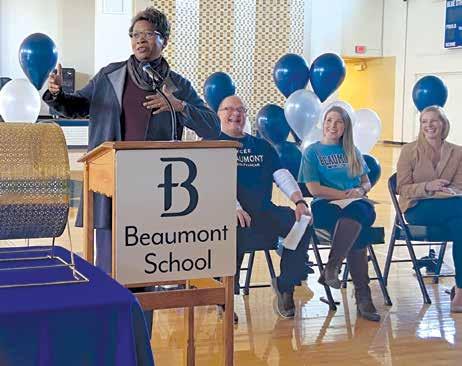BEAUMONT IN THE WORLD
Reflections on the people and beauty of
EL SALVADOR
By Wendy Hoke
order. With windows open in our bus we pulled onto the streets, past steers and horses, banana palms and sugar cane fields. I had spent the weeks leading up to the trip filling my notebook with what I didn’t know about El Salvador – its history, people, culture, religion, economy. The journalist in me wanted to record everything. But I was overwhelmed and instead closed my eyes, felt the wind and took in the sounds and smells. Our first stop was the Chapel of the American Churchwomen in Santiago Nonualco, some distance from the airport and our hotel. As we approached the chapel, I found myself wondering what it must have looked like to those four women on December 2, 1980. Did they know what was about to happen?
Sister Cheryl Mentkowski and Wendy Hoke
My knowledge of Central America in general and El Salvador in particular was filtered through my experience of growing up in the Jimmy Carter and Ronald Reagan years. The policies and events that led to the death of four American churchwomen were a mystery to me. But I remember vividly how shocked I was by the news of their deaths. It seemed impossible to my 13-year-old brain that anyone would have been threatened by the work of these holy women.
8
best, reflecting on who she was as a person. It was also time to restart our mission trip to El Salvador and get to know the people who were so important to Sister Dorothy. Last November, Sister Cheryl Mentkowski, OSU, Director of Mission Integration, and I made our first trip to El Salvador with a group from the Church of St. Dominic, which has a robust mission in the mountain town of Chiltiupan. This was the parish’s “relational” trip, perfect for our Ursuline experience.
The chapel is just off the now-paved road, next to a large meadow and under the shadow of an enormous tree. I found it equal parts haunting and peaceful. What has this tree witnessed? Sister Cheryl is overcome with emotion as she touches the marker describing how the women “gave over their lives” nearly 40 years ago. I held her as she wept. During the first of our daily masses, with roosters crowing outside, we are asked to keep our eyes and hearts open. Mira. (Look)
It wasn’t until I picked up Ursuline Sister Cynthia Glavec’s biography, “In the Fullness of Life,” over Thanksgiving two years ago that I learned about Sister Dorothy Kazel’s calling to serve the people of El Salvador. Her example moved me deeply and with her connection to Beaumont, was one that I felt must be taught and shared.
We left Cleveland on a chilly November morning and arrived in San Salvador to a blast of heat, humidity and sun. “Bienvenidos,” greeted us from a giant billboard along with tropical greenery and the hundreds of Salvadorans that lined the sidewalk scanning the new arrivals for their loved ones.
This was a trip to build relationships. We would spend the vast majority of our time on top of the mountain in the canton of Chiltiupan. On the long drive up the mountain, we bond with our fellow travelers and especially our guides. They sing and play guitar and make an amazing effort to get to know everyone beyond just a surface level. The conversations are deep, faith-filled, personal, funny, tragic and hopeful.
Over the past school year, students, faculty and staff dove deeply into the life and legacy of Sister Dorothy, reading her biography, learning firsthand from those who knew her
Within minutes of stepping outside, we were greeted by our guides and interpreters – Aine, Jesus, Herbert and Aristides – whom we would come to know and love in short
In Chiltiupan, we pile into the back of pickup trucks. For more than an hour we make our way through dirt trails, some of which were being cleared following the end of the rainy
BEAUMONT NEWS I A MAGAZINE FOR ALUMNAE AND FRIENDS OF BEAUMONT SCHOOL I SUMMER 2020












